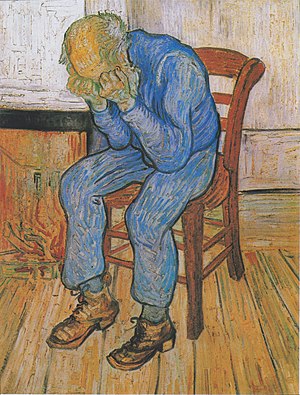
Major depressive disorder

Major depressive disorder (MDD), also known simply as depression, is a mental disorder characterized by at least two weeks of low mood that is present across most situations. It is often accompanied by low self-esteem, loss of interest in normally enjoyable activities, low energy, and pain without a clear cause. People may also occasionally have false beliefs or see or hear things that others cannot. Some people have periods of depression separated by years in which they are normal, while others nearly always have symptoms present. Major depressive disorder can negatively affect a person's personal life, work life, or education, as well as sleeping, eating habits, and general health. Between 2–8% of adults with major depression die by suicide, and about 50% of people who die by suicide had depression or another mood disorder. The cause is believed to be a combination of genetic, environmental, and psychological factors. Risk factors include a family history of the condition, major life changes, certain medications, chronic health problems, and substance abuse. About 40% of the risk appears to be related to genetics. The diagnosis of major depressive disorder is based on the person's reported experiences and a mental status examination. There is no laboratory test for major depression. Testing, however, may be done to rule out physical conditions that can cause similar symptoms. Major depression is more severe and lasts longer than sadness, which is a normal part of life. The United States Preventive Services Task Force (USPSTF) recommends screening for depression among those over the age 12, while a prior Cochrane review found that the routine use of screening questionnaires has little effect on detection or treatment. Typically, people are treated with counseling and antidepressant medication. Medication appears to be effective, but the effect may only be significant in the most severely depressed. It is unclear whether medications affect the risk of suicide. Types of counseling used include cognitive behavioral therapy (CBT) and interpersonal therapy. If other measures are not effective, electroconvulsive therapy (ECT) may be considered. Hospitalization may be necessary in cases with a risk of harm to self and may occasionally occur against a person's wishes. Major depressive disorder affected approximately 216 million people (3% of the world's population) in 2015. The percentage of people who are affected at one point in their life varies from 7% in Japan to 21% in France. Lifetime rates are higher in the developed world (15%) compared to the developing world (11%). It causes the second-most years lived with disability, after lower back pain. The most common time of onset is in a person's 20s and 30s. Females are affected about twice as often as males. The American Psychiatric Association added 'major depressive disorder' to the Diagnostic and Statistical Manual of Mental Disorders (DSM-III) in 1980. It was a split of the previous depressive neurosis in the DSM-II, which also encompassed the conditions now known as dysthymia and adjustment disorder with depressed mood. Those currently or previously affected may be stigmatized. Major depression significantly affects a person's family and personal relationships, work or school life, sleeping and eating habits, and general health. Its impact on functioning and well-being has been compared to that of other chronic medical conditions, such as diabetes. A person having a major depressive episode usually exhibits a very low mood, which pervades all aspects of life, and an inability to experience pleasure in activities that were formerly enjoyed. Depressed people may be preoccupied with, or ruminate over, thoughts and feelings of worthlessness, inappropriate guilt or regret, helplessness, hopelessness, and self-hatred. In severe cases, depressed people may have symptoms of psychosis. These symptoms include delusions or, less commonly, hallucinations, usually unpleasant. Other symptoms of depression include poor concentration and memory (especially in those with melancholic or psychotic features), withdrawal from social situations and activities, reduced sex drive, irritability, and thoughts of death or suicide. Insomnia is common among the depressed. In the typical pattern, a person wakes very early and cannot get back to sleep. Hypersomnia, or oversleeping, can also happen. Some antidepressants may also cause insomnia due to their stimulating effect. A depressed person may report multiple physical symptoms such as fatigue, headaches, or digestive problems; physical complaints are the most common presenting problem in developing countries, according to the World Health Organization's criteria for depression. Appetite often decreases, with resulting weight loss, although increased appetite and weight gain occasionally occur. Family and friends may notice that the person's behavior is either agitated or lethargic. Older depressed people may have cognitive symptoms of recent onset, such as forgetfulness, and a more noticeable slowing of movements. Depression often coexists with physical disorders common among the elderly, such as stroke, other cardiovascular diseases, Parkinson's disease, and chronic obstructive pulmonary disease. Depressed children may often display an irritable mood rather than a depressed one, and show varying symptoms depending on age and situation. Most lose interest in school and show a decline in academic performance. They may be described as clingy, demanding, dependent, or insecure. Diagnosis may be delayed or missed when symptoms are interpreted as 'normal moodiness.'
